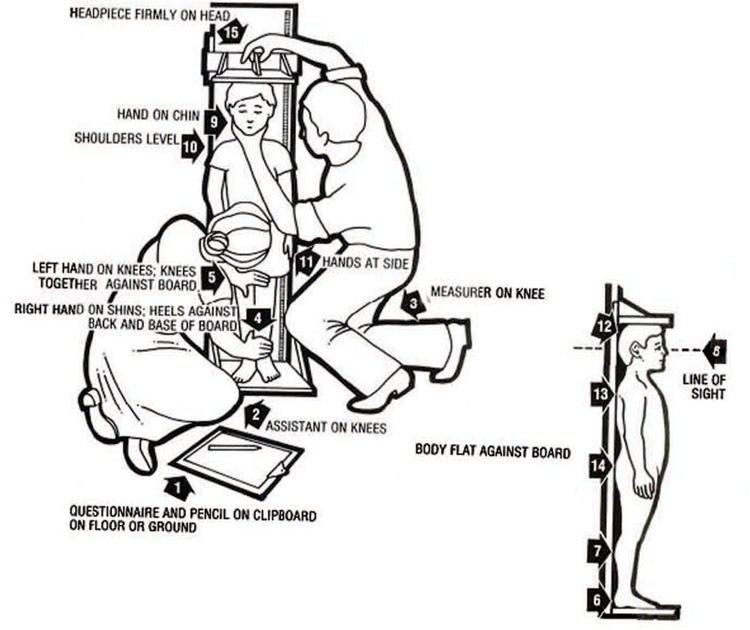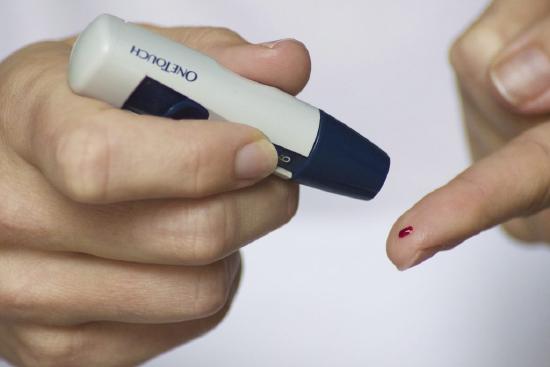3.14: Research Highlight - Nutrition Assessments
- Page ID
- 38028
Introduction
Nutritional assessment is the interpretation of anthropometric, biochemical (laboratory), clinical and dietary data to determine whether a person or groups of people are well nourished or malnourished (overnourished or undernourished).
Nutritional assessment can be done using the ABCD methods. These refer to the following:
- A. Anthropometry
- B. Biochemical methods
- C. Clinical methods
- D. Dietary methods
Anthropometry methods of assessing nutritional status
The word anthropometry comes from two words: Anthropo means ‘human’ and metry means ‘measurement’. The different measurements taken to assess growth and body composition are presented below.
To assess growth, several different measurements including length, height, weight, head circumference, mid-arm circumference, skin-fold thickness, head/chest ratio, and hip/waist ratio can be used. Height and weight measurements are essential in children to evaluate physical growth. As an additional resource, the NHANES Anthropometry Procedures Manual (revised January 2004) can be viewed here https://www.cdc.gov/nchs/data/nhanes/nhanes_03_04/BM.pdf

Biochemical methods of assessing nutritional status
Biochemical or laboratory methods of assessment include measuring a nutrient or its metabolite in the blood, feces, urine or other tissues that have a relationship with the nutrient. An example of this method would be to take blood samples to measure levels of glucose in the body. This method is useful for determining if an individual has diabetes.

Clinical methods of assessing nutritional status
In addition to the anthropometric assessments, you can also assess clinical signs and symptoms that might indicate potential specific nutrient deficiency. Special attention are given to organs such as skin, eyes, tongue, ears, mouth, hair, nails, and gums. Clinical methods of assessing nutritional status involve checking signs of deficiency at specific places on the body or asking the patient whether they have any symptoms that might suggest nutrient deficiency.
Dietary methods of assessing nutritional status
Dietary methods of assessment include looking at past or current intakes of nutrients from food by individuals or a group to determine their nutritional status. There are several methods used to do this:
24 hour recall
A trained professional asks the subject to recall all food and drink consumed in the previous 24 hours. This is a quick and easy method. However, it is dependent upon the subject’s short-term memory and may not be very accurate.
Food frequency questionnaire
The subject is given a list of foods and asked to indicate intake per day, per week, and per month. This method is inexpensive and easy to administer. It is more accurate than the 24 hour recall.
Food Diary
Food intake is recorded by the subject at the time of eating. This method is reliable but difficult to maintain. Also known as a food journal or food record.
Observed food consumption
This method requires food to be weighed and exactly calculated. It is very accurate but rarely used because it is time-consuming and expensive.
Evolving Science
Science is always moving forward, albeit sometimes slowly. One study is not enough to make a guideline or a recommendation, or cure a disease. Science is a stepwise process that builds on past evidence and finally culminates into a well-accepted conclusion. Unfortunately, not all scientific conclusions are developed in the interest of human health, and some can be biased. Therefore, it is important to know where a scientific study was conducted and who provided the funding, as this can have an impact on the scientific conclusions being made. For example, an air quality study paid for by a tobacco company diminishes its value in the minds of readers as well as a red meat study performed at a laboratory funded by a national beef association.
Nutritional Science Evolution
One of the newest areas in the realm of nutritional science is the scientific discipline of nutritional genetics, also called nutrigenomics. Genes are part of DNA and contain the genetic information that make up all of our traits. Genes are codes for proteins and when they are turned “on” or “off,” they change how the body works. While we know that health is defined as more than just the absence of disease, there are currently very few accurate genetic markers of good health. Rather, there are many more genetic markers for disease. However, science is evolving, and nutritional genetics aims to identify what nutrients to eat to “turn on” healthy genes and “turn off” genes that cause disease.
Using Science and Technology to Change the Future
As science evolves, so does technology. Both can be used to create a healthy diet, optimize health, and prevent disease. Picture yourself not too far into the future: you are wearing a small “dietary watch” that painlessly samples your blood, and downloads the information to your cell phone, which has an app that evaluates the nutrient profile of your blood and then recommends a snack or dinner menu to assure you maintain adequate nutrient levels. What else is not far off? How about another app that provides a shopping list that adheres to all dietary guidelines and is emailed to the central server at your local grocer, who then delivers the food to your home? The food is then stored in your smart fridge which documents your daily diet at home and delivers your weekly dietary assessment to your home computer. At your computer, you can compare your diet with other diets aimed at weight loss, optimal strength training, reduction in risk for specific diseases or any other health goals you may have. You also may delve into the field of nutritional genetics and download your gene expression profiles to a database that analyzes your genes against millions of others.

